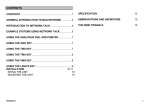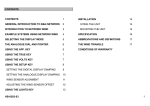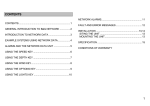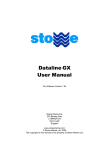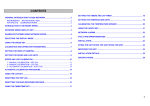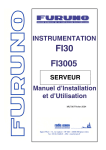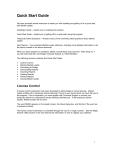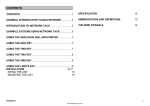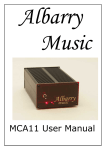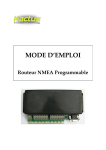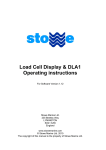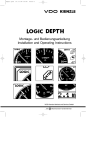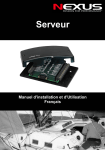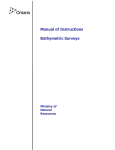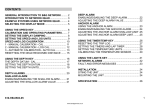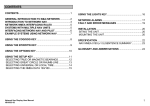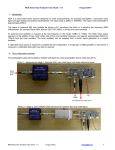Download Stowe Databox SD - Stowe Marine Electronics
Transcript
Dataline Databox SD User Manual For software version 1.01 Stowe Marine Limited 235 Bentley Way, LYMINGTON, SO41 8JW Tel: 01590 610071 Fax: 01590 610072 email: [email protected] www.stowemarine.com Introduction Congratulations on your purchase of the Databox SD from Stowe Marine. This Databox combines clever thinking with incredibly simple operation, and represents Stowe’s commitment to providing customers with the finest products. The Dataline Databox SD calculates Boat Speed, Depth, Sea Temperature and Battery Volts when connected to compatible sensors. It will also combine an additional NMEA input of data from other instruments, such as Mast Head Unit, GPS or Compass. The Databox SD can be used with any Stowe Speed and Depth sensors and can also be used with many sensors from other manufactures, (setting up via PC connected to USB may be necessary). Before you begin using your new Stowe Databox, please take the time to read this manual to help you achieve the full potential. Certification This device meets requirements for CFR47 Part 15 of the FCC limits for Class B equipment, and meets the standards set out in European Standard EN 60945: 1997 IEC 945: 1996 for maritime navigation and radiocommunication equipment and systems. Disclaimer Stowe Marine Limited accept no responsibility for the use of this equipment. This equipment is not designed to replace conventional navigation procedures. Information in this document is subject to change without notice. Stowe Marine Limited reserve the right to change its products and documentation without obligation to notify any person or organisation of such changes. Installation The Databox SD must be mounted in a dry location with easy access. All cables should be supported with clips on the bulkhead close to the Databox opening. Power Supply This unit is designed to operate on a 12 volt system. An external fuse MUST be connected with a MAXIMUM of 2 Amp rating. Wind, GPS or Heading NMEA Input This input can be used to ‘multiplex’ data into the Databox SD data stream. To connect more than one device, a further NMEA Combiner/Multiplexer must be used. When using the Stowe NMEA Mast Head Unit, the Red wire connects together with the +12V input and a link must be connected between the 0V input and NMEA In B. See diagram on last page for details. Dataline Databus This unit is designed to be used with the Stowe Dataline GX displays, but attention has also been taken to make it backwards compatible with older Dataline displays and also standard NMEA. For Dataline GX displays, simply connect colour for colour for Red, Black, White, Green and Brown. For older displays, connect colour for colour, but also add a link between Black and Green. On older Dataline displays with an orange right hand lighting button, the unit must be set to ‘old Dataline’ via a PC connected to USB. For NMEA output, use White as NMEA ‘A’, signal or + and Black as NMEA ‘B’, return or ground. Boat Speed/Log Sensor The sensor must be positioned so that it is always under water, near the centreline but at least 150mm away from the keel either side. In a sailing yacht a position 150mm forward of the keel is preferable in order to minimise tack to tack speed inaccuracies, caused by flow past the leading edge. For powered vessels, position just ahead of the engines for access, minimal electrical interference, and correct speed function. Do not put in line with the propeller/s. Recommended positions: The hole for the skin fitting should be positioned well clear of any internal frames or stringers. Keep clear of strop lifting points and areas where damage could result from trailing or launching. Ensure good access for removal of the paddlewheel assembly and the subsequent mopping up of water spilled. Drill a small pilot hole first and check its location inside and out, then using a 45mm (1¾") diameter cutter in a hand or electric drill cut the required hole. Assemble the skin fitting and nut using a good sealing compound such as Sikaflex to make watertight. Do not over tighten the nut. The paddlewheel transducer should be installed in the skin fitting with the handle pointing fore and aft. Any other alignment may give faulty readings. It may be found that different speed readings are obtained on opposite tacks, and to overcome or reduce this error, turn the transducer a little. If a suitable position is found which gives equal speeds on both tacks, then mark the position on the hull for future reference when removing, cleaning and replacing. When transporting or anti-fouling the boat, always have the blanking cap fitted. It is important to anti-foul the skin fitting as well as the hull, as weed growth around it can cause the log to give incorrect readings or stop. Do not coat the bore of the skin fitting. WARNING - The whole assembly should be checked for leaks immediately the vessel is launched, and rechecked within 8 to 24 hours. The transducer cable should be routed away from all other cables to or from the Databox, and via the shortest practical route. The cable must not be included in the main wiring loom. If the most direct route is near sources of interference such an engine or fluorescent lights, etc., then a longer route away from these must be chosen. The log and sounder transducer cables may have to follow a similar route, but must not be tied together at any point along their length. A 10mm gap is recommended between these cables. Depth Transducer To maximise performance of this transducer it should be mounted through the hull with the face of the transducer in direct contact with the water. The position should be well below the waterline in an area of minimum turbulence, e.g. not behind or under hull projection or outlet pipe likely to generate air bubbles. The sounder face should be within 18 degrees of horizontal to maintain range. On a yacht, a position ahead of the keel is ideal. In a faster powerboat a position aft is preferable. If the transducer can not be flush with the hull, a wooden fairing block will be required with a matching block inside the hull. The process of fitting the sounder transducer is similar to that of the log transducer. Do not over tighten the nut. Do not apply any physical force or impact to the transducer face. Do not use high pressure water cleaners on the face of this transducer. Anti-fouling should be limited to one thin coat over the face. Clean off between seasons with fine ‘wet and dry’ sandpaper. The transducer cable must be routed well clear of sources of electrical interference, e.g. alternators and ignition wiring. Check for correct operation before final fixing. You may shorten the transducer cable. Databox SD Dataline Sentences Dataline sentence structure is based on NMEA 0183 V1.5, but not always fully compliant. Examples below: DBK Depth Below Keel $IIDBK,0002.0,f,,,, DBT Depth Below Transducer $IIDBT,0002.5,f,0000.7,M,, VHW Boat Speed $IIVHW,,,,,M,00.00,N,, VLW Log $IIVLW,0000.0,N,000.02,N MTW Water Temperature $IIMTW,-03.9,C VWR Wind Data Relative (Only output if NMEA MHU fitted) $IIVWR,035,L,05.4,N,,,, Propriety Raw Boat Speed and Depth $PSTOF,00.00,0002.0,5,,,,, Propriety Battery Volts $PSTOB,12.2,v Propriety Depth Keel Offset $PSTOD,-00.5,f NMEA Sentences (NMEA mode only) NMEA 0183 V2 sentence structure, examples below: DBT Depth Below Transducer $IIDBT,0002.5,f,0000.7,M,,*hh DPT Depth Calibrated $IIDPT,0000.7,,000.0,*hh VHW Boat Speed $IIVHW,,,,,M,00.00,N,,*hh VLW Log $IIVLW,0000.0,N,000.02,N*hh MTW Water Temperature $IIMTW,-03.9,C*hh VWR Wind Data Relative (Only output if NMEA MHU fitted) $IIVWR,035,L,05.4,N,,,,*hh Calibration The Databox SD is usually calibrated via Dataline displays connected to the Dataline Bus. Please see display manual for calibration of Boat Speed/ Log, Depth and Wind. Additional calibration is available to advanced users or engineers who have installed the USB driver on a suitably equipped PC. No advanced calibration should be necessary if the unit has been ordered with the correct specification! Engineers USB Page The unit does not require power to perform setting up as it can derive power from the USB port. However, it will not fully function without external power. As far as the host PC is concerned, the NMEA Databox appears to be a COM port, (RS232). Note that other than selecting the correct COM port, no other settings are necessary… you do not have to select baud rate etc., this is automatic. To find the correct com port, either: 1. 2. Check in Windows Vista or XP ‘Device Manager’ under ‘Ports (COM & LPT)’; the interface will be listed as ‘TINLEY USB to UART (COM X)’ where X = COM port number. The interface must be plugged in and driver loaded. Open software, (such as Hyperterminal or your navigation package), without the interface plugged in and check the available COM ports under ‘Properties’ or similar. Close ‘Properties’ and Plug in interface. Now check the available COM ports again, noting the new one! Some software may require closing and re-opening to see the new port. Note that the COM port number is specific to the USB port in use… if you change the USB port, the COM port will also change. Open the COM port in Hyperterminal and the interface will output the following start-up message: Stowe Marine Limited (c) 2009 Databox X.XX-X.XXX Stowe Transducer 204.8kHz * ALWAYS CONNECT USB BEFORE OPENING APPLICATION * The following functions can now be set: Important note: Do not press [ ]<>0+- keys, as these undocumented factory adjustments will adversely effect performance requiring return of unit to factory. Output format Dataline or NMEA The early Dataline displays, (with an orange lighting button), require a slightly modified output for depth to function correctly: Press ‘A’ for old Stowe DBK message. Unit responds: Stowe DBK message format Press ‘S’ for Standard DBK message for DatalineX, IS11 or Dataline GX. Unit responds: Normal DBK message format Press ‘N’ for NMEA 0183 compatible output format. Unit responds: NMEA message format Depth Transducer To set frequency of depth transducer or NMEA input of depth: Press ‘1’ for 150kHz Press ‘2’ for 170kHz Press ‘3’ for 200kHz Press ‘4’ for 204.8kHz (Standard Stowe Transducer) Press ‘5’ for NMEA input of depth and switch off depth transmitter. Unit responds with output type, for example: Stowe Transducer 204.8kHz Installing Driver Information for advanced users or engineers only The driver is not normally supplied with the unit, but is available for download from our website: www.stowemarine.com The driver only has to be installed the first time the interface is plugged into a USB port. The following example is for windows XP. 1: Plug interface into required 3: Ignore warning and click USB port. ‘Found New Hardware ‘Continue anyway’ Wizard’ will be displayed. Select ‘No, not this time’ and click ‘Next’ 4: Wait for software to load and click ‘Finish’ 2: Insert CD. If windows does not automatically detect CD then click ‘Next’ +12V 0V GND NMEA In A NMEA In B Brown Green White Black Red B/Speed I/P Temp I/P 0 Volts Depth + Depth - Specifications Boat Speed Depth Log Sea Temperature Battery Voltage Current 0 to 99.99 knots, resolution 0.01 knot 0.8 to 120m, resolution 0.1m Cumulative 0 to 9999.9 nm, resolution 0.1nm -5 to 40 degrees centigrade 10 to 16 Volts, resolution 0.1V 50mA + requirements for up to 15 displays













